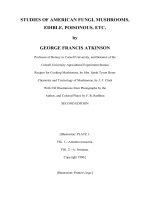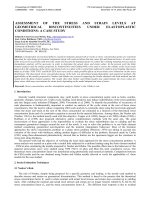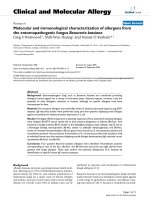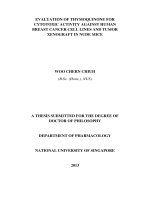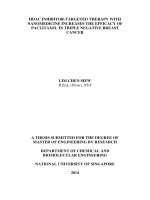Efficacy of entomopathogenic fungi, Beauveria bassiana against maruca vitrata (Geyer) under laboratory condition
Bạn đang xem bản rút gọn của tài liệu. Xem và tải ngay bản đầy đủ của tài liệu tại đây (345.72 KB, 12 trang )
Int.J.Curr.Microbiol.App.Sci (2019) 8(9): 1060-1071
International Journal of Current Microbiology and Applied Sciences
ISSN: 2319-7706 Volume 8 Number 09 (2019)
Journal homepage:
Original Research Article
/>
Efficacy of Entomopathogenic Fungi, Beauveria bassiana against
Maruca vitrata (Geyer) under Laboratory Condition
K. Haripriya1*, S. Jeyarani1, S. Mohankumar2 and R. P. Soundararajan3
1
Department of Agricultural Entomology, 2Center for Plant Molecular Biology &
Biotechnology, 3Department of rice, Tamil Nadu Agricultural University,
Coimbatore- 641003, India
*Corresponding author
ABSTRACT
Keywords
Maruca vitrata,
Beauveria bassiana,
LC 50 and LT50
Article Info
Accepted:
12 August 2019
Available Online:
10 September 2019
Pathogenecity of entomopathogenic fungi, Beauveria bassiana isolates
(Bb111, Bb112, Bb 113 and Bb 114) were assessed against spotted pod
borer, Maruca vitrata (Geyer). Bioassays were performed in five different
pulse hosts viz., lablab, cowpea, green gram, black gram and pigeonpea
against third, fourth and fifth instar larvae of spotted pod borer. Efficacy of
Bb 112 was higher irrespective of the pulses tested. The median lethal
concentrations of Bb 112 for third, fourth and fifth instar larvae on different
pulses viz., lablab, cowpea, black gram, green gram and pigeonpea were
in range of 0.10 x 108 to 2. 04 x 108, 0.14 x 108 to 2.67 x 108 and 0.20 x 108
to 4.80 x 108 spores ml-1, respectively.
Introduction
The spotted pod borer, commonly known as
legume pod borer, M. vitrata (Lepidoptera:
Crambidae) is a serious pest of grain legumes
in the tropics and subtropics due to its
extensive host range, distribution and
destructiveness. The larvae damage the
flower buds, flowers and immature pods by
webbing and contaminate with their excreta
(Rekha and Mallapur, 2007). The grain yield
loss due to legume pod borer was estimated
to be 10.0 to 80.0 per cent in various crops
(Singh and Allen, 1980; Sharma, 1998).
Webbings of flowers and pods during
feeding makes the pest hard to reach and
hence makes the management difficult
(Sharma, 1998). However, the pest is still
being managed by means of insecticides only
(Jakhar et al., 2016).
Preference of insecticides depends on their
easy availability and applicability, but their
excessive and indiscriminate use resulted in
the development of insecticidal resistance in
most
of the pests and environmental
pollution (Phokela et al., 1990; Sharma et al.,
2002). The increasing concern about
1060
Int.J.Curr.Microbiol.App.Sci (2019) 8(9): 1060-1071
pesticide hazards evoked worldwide interest
on alternate pest management practices that
are ecofriendly in nature. Biologically
derived insecticides or microbial insecticides,
natural enemies and entomopathogenic fungi
provide an alternative, more environmentally
friendly option to control this insect pest.
Entomopathogens are being reported as the
most important regulating factors of
M. vitrata under field condition. The
usefulness and effectives of Bacillus
thuringiensis was reported against M. vitrata
(Karel et al., 1986). Srinivasan et al., (2015)
suggested B. thuringiensis based biopesticide
formulation as the promising component for
the integrated management of M. vitrata.
Sreelakshmi and Paul (2016) reported the
efficacy of spinosad and emamectin benzoate
(insecticide based on microbial derivative)
against M. vitrata infesting pulses. The
entomopathogenic
fungus
Beauveria
bassiana is a promising and extensively
researched biological control agent that can
suppress a variety of economically important
insect pests (Coates et al., 2002; McGuire et
al., 2005: Prasad and Syed, 2010; Hussein et
al., 2010). Soundararajan and Chitra (2011)
reported the potential of B. bassiana against
M. vitrata population under field condition
on urdbean. In the present investigation,
laboratory efficacy of B. bassiana isolates
were tested against different life stages of M.
vitrata.
Preparation of spore suspensions of fungal
isolates for bioassay
For laboratory bioassay, all the four isolates
were cultured in Petri dishes (9 cm diameter)
containing Sabouraud’s Maltose Agar
enriched with one per cent yeast extract
(SMA+Y) solid medium and incubated at 25 ±
2o C for 10 to 14 days. After complete
sporulation, spores were scraped from the
surface of SMAY plates and suspended in 20
ml sterile distilled water containing 0.05 per
cent Tween 80® (Sisco Research Laboratories
Pvt Ltd, Mumbai, India). The conidial
suspension was vortexed for 5 minutes to
produce a homogenous spore suspension
(Saranya et al., 2013). Spore count in each
plate was assessed using a Neubauer
hemocytometer with a phase contrast
microscope
(Leica
DM750,
Leica
Microsystems, Heerbrugg, Switzerland) and
was estimated using the formula suggested by
Lomer and Lomer (1996). The number of
spores ml-1 was calculated by the following
formula.
Number of spores ml-1 of suspension = DX/NK, where
D = Dilution factor
X= Total number of spores
N= Number of small squares counted
K=Volume above one small square in cm3 (2.5 x 10-7 cm3)
From the stock solution, dilutions were made
to obtain the required concentrations for
further studies.
Method of bioassay
Materials and Methods
Sources of fungal isolates used for the study
Pure cultures of the different isolates of
entomopathogenic
fungi,
B.
bassiana
maintained at the Department of Agricultural
Entomology, Tamil Nadu Agricultural
University (TNAU), Coimbatore were utilized
for the laboratory bioassay.
Larvae of M. vitrata from the laboratory
cultures maintained at Insectary in Tamil
Nadu Agricultural University were used for
the bioassays.
For each isolate, five different spore
concentrations (1x108 to 1x104 spores ml-1)
were prepared from the stock suspension for
the assay of concentration mortality response.
The whole fresh pods of different pulses viz.,
1061
Int.J.Curr.Microbiol.App.Sci (2019) 8(9): 1060-1071
lablab, cowpea, green gram, black gram and
pigeonpea were placed separately in a plastic
disposable container (10 cm dia and 3.5 cm
ht.) lined with a cotton wad (8 cm dia.) and
water-soaked filter paper to ensure high
relative humidity. For each treatment forty
prestarved third instar larvae were released at
the rate of 10 per container. Four replications
were used for each isolate and each
concentration.
After 6 hrs of release (i.e. after larvae entered
into the pod), ten ml of respective
concentrations were sprayed on the pods
infested with third instar larvae using glass
atomizer. Pods sprayed with 0.05 per cent
Tween 80® served as control.
The most preferred host was used as a positive
control for comparing the pathogenicity. After
spraying, post treatment counts were taken at
24 hours interval upto 7 days and the median
lethal concentration (LC 50) was worked out
according to the probit analysis methodology
(Finney, 1971).
Similar experimental setup was used for the
time mortality response studies. The time
mortality response was carried out at higher
spore concentration of 1 × 108 spores ml-1.
Pods sprayed with 0.05 per cent Tween 80®
served as control.
The post treatment counts were taken at 12
hours interval upto 7 days and the median
lethal time (LT50) was worked out according
to the probit analysis methodology (Finney,
1971).
In both bioassays, dead larvae were collected
daily and kept in humid chamber. Dead larvae
which produced mycelial growth were
considered for the mortality count (IRAC,
2007). Similar procedure was adopted for 4th
instar and 5th instar larvae using different
pulse crops.
Results and Discussion
Median lethal concentration (LC50) against
M. vitrata larvae
The results of the bioassay showed that all the
tested fungal isolates were effective against all
the instars tested on different pulses. Among
all the isolates, Bb 112 had higher virulence to
M. vitrata larvae, irrespective of the pulses
tested. The median lethal concentrations of Bb
112 for third, fourth and fifth instar larvae on
different pulses viz., lablab, cowpea, black
gram, green gram and pigeonpea were in
range of 0.10 x 108 to 2. 04 x 108, 0.14 x 108
to 2.67 x 108 and 0.20 x 108 to 4.80 x 108
spores ml-1, respectively (Table 1, 2 and 3).
The efficacy of Bb 112 against third instar on
different pulses were in the order of lablab >
cowpea > black gram > green gram >
pigeonpea with the LC50 values of 0.10, 0.13,
0.15, 0.33 and 0.52 x 108 spores ml-1,
respectively. This was followed by the isolates
Bb 111, Bb 113 and Bb 114. Similar trend was
also observed against fourth and fifth instar,
with the LC50 values of 0.14, 0.41, 0.46, 0. 53
and 0.79 x 108 spores ml-1 and 0.20, 0.48,
0.60, 0.92 and 1.73 x 108 spores ml-1,
respectively on lablab, cowpea, black gram,
green gram and pigeonpea.
Median lethal time (LT50) against M. vitrata
larvae
The results of the bioassay revealed distinct
variation in time response of all the fungal
pathogens (at higher concentration 1 x 108
spores ml-1) tested against different instars of
M. vitrata larvae.
The isolate Bb 112 had faster lethal effect
against third, fourth and fifth instar larvae
followed by Bb 113, Bb 114 and Bb 111. The
median lethal time for Bb 112 against third,
fourth and fifth instar larvae of different
pulses were found to be in range of 110.48 to
1062
Int.J.Curr.Microbiol.App.Sci (2019) 8(9): 1060-1071
125.93 h, 114.01 to 131.76 h and 120.69 to
147.97 h, respectively (Table 4, 5 and 6). The
lowest LT50 of 110.48, 114.01 and 120.69 h
was recorded against third, fourth and fifth
instar, respectively on lablab treated with Bb
112.
Microbial
insecticides
such
as
entomopathogenic fungi can provide an
alternative, more environmentally friendly
option to control insect pest. The
entomopathogenic fungus, B. bassiana is a
promising and extensively researched
biological control agent that can suppress a
variety of economically important insect pests
(Coates et al., 2002; McGuire et al., 2005;
Prasad and Syed, 2010; Hussein et al., 2010).
Hence, in the present investigation four fungal
isolates of B. bassiana viz., Bb 111, Bb 112,
Bb 113 and Bb 114 were assayed for its
relative pathogenicity against M. vitrata. The
results of the laboratory study showed that the
isolate, Bb 112 had higher virulence to M.
vitrata larvae with a LC50 values ranged from
0.10 x 108 to 2. 04 x 108, 0.14 x 108 to 2.67 x
108 and 0.20 x 108 to 4.80 x 108 spores ml-1,
respectively against third, fourth and fifth
instar larvae on different pulse hosts viz.,
lablab, cowpea, black gram, green gram and
pigeonpea. Several studies have confirmed the
susceptibility
of
M.
vitrata
to
entomopathogenic fungi such as B. bassiana
and M. anisopliae isolates and/or their
formulations (Ekesi et al., 2002; Sunitha et al.,
2008). Yule and Srinivasan (2013) reported 16
to
22
per
cent
mortality
of
M. vitrata by B. bassiana formulation at a
concentration of 5,000 to 50,000 ppm. Similar
results were also documented by Sreekanth
and Seshamahalakshmi (2012). According to
them, pigeonpea treated with highest dose
(300 mg L-1) of B. bassiana SC formulation
recorded reduced pod damage by M. vitrata.
Mehinto et al., (2014) reported a larval
mortality of 65.8 ± 3.5 to 79.0 ± 3.0 per cent
when treated with B. bassiana isolate Bb 115.
Similarly, Soundararajan and Chitra (2011)
also reported that the foliar application of B.
bassiana reduced the spotted pod borer
damage in urd bean.
Present investigation also revealed that
irrespective of the isolates tested, younger
larvae (third instar) are more vulnerable to
fungal infection than older ones (fourth and
fifth instar). This is in accordance with
Bateman et al., (1996) who reported that the
infection of insects by fungi depends on their
weight. Also, the higher mortality caused by
B. bassiana may be attributed to its stronger
ability to produce enzymes and other toxic
metabolites (Ferron, 1981).
The details of the fungal isolates used for the study were as follows:
Isolate
B. bassiana (Bb 111)
B. bassiana (Bb 112)
B. bassiana (Bb 113)
B. bassiana (Bb 114)
Isolate source
Tetranychus urticae Koch
Unknown larva
Rice black bug
Bombyx mori L.
1063
Dosage tested
10 to 108 spores ml-1
104 to 108 spores ml-1
104 to 108 spores ml-1
104 to 108 spores ml-1
4
Int.J.Curr.Microbiol.App.Sci (2019) 8(9): 1060-1071
Table.1 Dose mortality response of B. bassiana against third instar larvae of M. vitrata on different pulses
Pulses
Fungal isolate
Heterogeneity ( χ2)
Regression equation
Bb 111
1.75
y = 0.573x + 1.735
LC50
(10 spores ml-1)
0.47
Bb 112
1.62
y = 0.658x + 1.320
0.10
0.16-0.73
Bb 113
1.34
y = 0.587x + 1.413
1.16
0.52-2.58
Bb 114
1.29
y = 0.574x + 1.596
0.79
0.35-1.78
Bb 111
1.09
y = 0.465x + 2.318
0.62
0.23-1.62
Bb 112
1.69
y = 0.456x + 2.716
0.13
0.04-0.39
Bb 113
1.22
y = 0.375x + 2.825
0.65
0.20-2.05
Bb 114
1.79
y = 0.495x + 1.986
1.09
0.44-2.72
Bb 111
1.08
y = 0.688x + 0.959
0.67
0.34-1.33
Bb 112
1.91
y = 0.655x + 1.410
0.33
0.15-0.72
Bb113
1.01
y = 0.502x + 2.071
0.70
0.29-1.72
Bb 114
1.67
y = 0.653x + 0.963
1.40
0.67-2.94
Bb 111
1.20
y = 0.552x + 1.580
0.19
0.06- 3.32
Bb 112
1.11
y = 0.489x + 2.530
0.15
0.03-0.31
Bb 113
1.71
y = 0.665x + 1.195
0.48
0.24-0.97
Bb 114
1.16
y = 0.516x + 1.809
1.47
0.61-3.55
Bb 111
1.39
y = 0.719x + 0.422
1.04
1.01-4.12
Bb 112
1.33
y = 0.616x + 1.454
0.52
0.24-1.12
Bb 113
1.15
y = 0.564x + 1.517
1.37
0.60-3.11
Bb 114
1.32
y = 0.544x + 1.597
1.68
0.72-3.95
Pigeonpea
Black gram
Green
gram
Cowpea
Lablab
8
* All lines are significantly good fit @ P ≤ 0.05
1064
95% Fiducial Limits
(108 spores ml-1)
0.21-1.06
Int.J.Curr.Microbiol.App.Sci (2019) 8(9): 1060-1071
Table.2 Dose mortality response of B. bassiana against fourth instar larvae of M. vitrata on different pulses
Pulses
Fungal isolate
Heterogeneity ( χ2)
Regression equation
Bb 111
1.21
y = 0.539x + 1.719
LC50
(10 spores ml-1)
1.16
Bb 112
1.44
y = 0.621x + 1.802
0.14
0.05-0.34
Bb 113
1.32
y = 0.544x + 1.597
1.68
0.72-3.95
Bb 114
1.03
y = 0.509x + 1.715
2.67
1.07-6.66
Bb 111
1.37
y = 0.505x + 2.011
0.79
0.32-1.91
Bb 112
1.34
y = 0.614x + 1.497
0.41
0.21-0.99
Bb 113
1.14
y = 0.627x + 1.269
0.78
0.37-1.65
Bb 114
1.68
y = 0.442x + 2.331
1.18
0.43-3.19
Bb 111
1.62
y = 0.745x + 0.487
1.17
0.60-2.32
Bb 112
1.18
y = 0.612x + 1.474
0.53
0.25-1.15
Bb113
1.39
y = 0.645x + 1.009
1.35
0.64-2.85
Bb 114
1.67
y = 0.725x + 0.395
2.09
1.03-4.21
Bb 111
1.89
y = 0.692x + 0.871
0.98
0.48-1.99
Bb 112
1.01
y = 0.528x + 2.034
0.46
0.17-0.99
Bb 113
1.25
y = 0.599x + 1.356
1.15
0.53- 2.52
Bb 114
1.08
y = 0.620x + 1.094
1.84
0.85-3.97
Bb 111
1.45
y = 0.643x + 0.725
2.10
1.83-9.17
Bb 112
1.28
y = 0.574x + 1.596
0.79
0.35-1.78
Bb 113
1.83
y = 0.548x + 1.595
1.48
0.63-3.45
Bb 114
1.09
y = 0.611x + 1.135
1.93
0.88-4.23
Pigeonpea
Black gram
Green
gram
Cowpea
Lablab
8
* All lines are significantly good fit @ P ≤ 0.05
1065
95% Fiducial Limits
(108 spores ml-1)
0.50-2.71
Int.J.Curr.Microbiol.App.Sci (2019) 8(9): 1060-1071
Table.3 Dose mortality response of B. bassiana against fifth instar larvae of M. vitrata on different pulses
Pulses
Fungal isolate
Heterogeneity ( χ2)
Regression equation
LC50
(10 spores ml-1)
2.90
0.20
3.43
2.10
0.90
0.48
0.96
2.08
0.96
0.92
2.73
2.94
1.99
0.60
2.13
2.31
2.16
1.73
3.83
4.80
8
Pigeonpea
Black
gram
Green
gram
Cowpea
Lablab
Bb 111
1.20
Bb 112
1.08
Bb 113
1.98
Bb 114
1.45
Bb 111
1.50
Bb 112
1.00
Bb 113
1.30
Bb 114
1.51
Bb 111
1.30
Bb 112
1.83
Bb113
1.31
Bb 114
1.62
Bb 111
1.04
Bb 112
1.97
Bb 113
1.23
Bb 114
1.24
Bb 111
1.94
Bb 112
1.02
Bb 113
1.67
Bb 114
1.31
* All lines are significantly good fit @ P ≤ 0.05
y = 0.574x + 1.273
y = 0.417x + 3.189
y = 0.652x + 0.705
y = 0.643x + 0.725
y = 0.422x + 2.473
y = 0.599x + 1.610
y = 0.611x + 1.322
y = 0.591x + 1.242
y = 0.611x + 1.322
y = 0.497x + 2.027
y = 0.708x + 0.408
y = 0.679x + 0.577
y = 0.518x + 1.719
y = 0.745x + 0.644
y = 0.602x + 1.246
y = 0.600x + 1.176
y = 0.573x + 1.342
y = 0.690x + 0.493
y = 0.638x + 0.768
y = 0.636x + 0.738
1066
95% Fiducial Limits
(108 spores ml-1)
1.22-6.73
0.04- 1.00
1.57-7.72
1.83-9.17
0.32-2.55
0.22-1.06
0.44-2.08
0.92-4.65
0.44-2.08
0.37-2.27
1.34-5.58
1.30-6.29
0.82-4.84
0.31-1.18
1.53-4.83
1.04-5.12
0.93-4.98
1.50-6.60
1.71-8.59
2.12-10.90
Int.J.Curr.Microbiol.App.Sci (2019) 8(9): 1060-1071
Table.4 Time mortality response of B. bassiana against third instar larvae of M. vitrata on different pulses
Fungal isolate
Heterogeneity ( χ2)
Regression equation
Bb 111
Bb 112
Bb 113
Bb 114
1.67
1.52
2.64
2.18
Bb 111
Bb 112
Bb 113
Bb 114
Bb 111
Bb 112
Bb113
y = 4.561x - 4.528
y = 5.208x - 5.569
y = 5.712x - 6.749
y = 4.209x - 3.744
LT50
(h)
122.61
110.48
115.48
119.77
95% Fiducial Limits
(h)
110.43- 136.13
101.04 - 120.79
106.60- 125.11
106.37- 134.86
1.22
2.71
1.30
1.74
1.55
1.46
1.55
y = 4.315x - 4.082
y = 5.014x - 5.217
y = 5.426x - 6.229
y = 4.250x - 3.873
y = 5.162x - 5.700
y = 5.866x - 6.953
y = 5.486x - 6.279
125.93
111.72
117.84
122.16
118.20
112.23
116.39
112.25 - 141.28
101.82 - 122.59
108.13 - 128.42
108.58 - 137.43
107.69 - 129.73
103.56 - 121.63
106.60 - 127.07
Bb 114
2.03
Bb 111
1.84
Bb 112
1.21
Bb 113
1.98
Bb 114
1.71
Bb 111
1.80
Bb 112
2.57
Bb 113
1.55
Bb 114
1.64
* All lines are significantly good fit @ P ≤ 0.05
y = 5.334x - 6.030
y = 4.396x - 4.208
y = 5.658x - 6.590
y = 3.389x - 1.985
y = 4.928x - 5.246
y = 4.970x - 5.371
y = 5.672x - 6.602
y = 5.166x - 5.699
y = 4.938x - 5.293
117.46
125.22
113.46
114.95
120.69
121.81
115.44
119.08
120.25
107.61 - 128.21
109.83 - 142.76
104.54 - 123.14
100.05 - 132.06
108.92 - 133.73
110.18 - 134.66
104.42 - 123.23
108.27 - 130.98
109.45 - 134.32
Pigeonpea
Black
gram
Green
gram
Cowpea
Lablab
Pulses
1067
Int.J.Curr.Microbiol.App.Sci (2019) 8(9): 1060-1071
Table.5 Time mortality response of B. bassiana against fourth instar larvae of M. vitrata on different pulses
Pigeonpea
Black gram
Green
gram
Cowpea
Lablab
Pulses
Fungal isolate
Heterogeneity ( χ2)
Regression equation
LT50 (h)
Bb 111
2.72
y = 4.286x - 4.042
126.95
95% Fiducial Limits
(h)
113.22 - 142.35
Bb 112
1.79
y = 5.838x - 6.940
114.01
105.35- 123.38
Bb 113
2.37
y = 4.358x - 4.069
120.48
107.69 - 134.80
Bb 114
5.18
y = 4.446x - 4.322
123.70
110.96 - 137.89
Bb 111
1.89
y = 3.637x - 2.717
129.76
113.00 - 149.02
Bb 112
1.03
y = 5.320x - 6.000
117.80
107.84 - 128.69
Bb 113
1.70
y = 3.890x - 3.166
125.63
109.31 - 144.39
Bb 114
3.44
y = 4.222x - 3.915
127.48
113.01 - 143.82
Bb 111
2.48
y = 4.766x - 5.054
127.60
114.31 - 142.44
Bb 112
1.39
y = 4.301x - 3.920
110.31
105.61 - 132.47
Bb113
3.44
y = 4.012x - 3.454
127.30
111.58 - 145.24
Bb 114
1.34
y = 4.542x - 4.558
127.35
112.33 - 144.37
Bb 111
1.47
y = 4.609x - 4.707
127.36
113.03 - 143.50
Bb 112
2.10
y = 5.789x - 6.762
118.28
101.73 - 119.62
Bb 113
1.03
y = 2.846x - 0.946
122.67
102.12 - 147.37
Bb 114
1.87
y = 4.396x - 4.230
126.64
110.76 - 144.78
Bb 111
1.35
y = 4.346x - 4.203
131.76
114.53 - 151.58
Bb 112
1.41
y = 4.097x - 3.551
121.78
107.48 - 137.99
Bb 113
1.11
y = 4.685x - 4.774
122.33
109.00 - 137.28
Bb 114
2.57
y = 3.906x - 3.261
129.57
112.63 - 149.04
* All lines are significantly good fit @ P ≤ 0.05
1068
Int.J.Curr.Microbiol.App.Sci (2019) 8(9): 1060-1071
Table.6 Time mortality response of B. bassiana against fifth instar larvae of M. vitrata on different hosts
Pigeonpea
Black gram
Green gram
Cowpea
Lablab
Pulses
Fungal isolate
Heterogeneity ( χ2)
Regression equation
Bb 111
1.10
Bb 112
y = 4.003x - 3.460
LT50
(h)
128.64
95% Fiducial Limits
(h)
112.55 - 147.02
1.49
y = 4.198x - 3.735
120.69
106.99 - 136.15
Bb 113
1.11
y = 3.767x - 2.924
127.18
109.56 - 147.62
Bb 114
1.69
y = 4.515x - 4.506
127.45
112.61 - 144.25
Bb 111
1.93
y = 3.381x - 2.224
138.25
113.79 - 167.95
Bb 112
1.33
y = 3.893x - 3.183
126.40
109.87 - 145.42
Bb 113
1.91
y = 4.308x - 4.130
131.97
114.87 - 151.61
Bb 114
1.46
y = 3.804x - 3.099
133.32
114.69 - 154.99
Bb 111
1.88
y = 3.751x - 2.937
135.47
112.09 - 151.85
Bb 112
3.38
y = 3.549x - 2.499
128.96
110.86 - 150.00
Bb113
1.39
y = 4.894x - 5.153
129.84
107.01 - 131.98
Bb 114
5.26
y = 4.728x - 5.011
132.58
115.99 - 144.76
Bb 111
1.15
y = 3.985x - 3.658
147.97
123.93 - 176.67
Bb 112
3.33
y = 3.843x - 3.151
131.36
113.62 - 151.88
Bb 113
1.99
y = 4.555x - 4.661
133.06
116.03 - 148.05
Bb 114
1.87
y = 4.349x - 4.247
133.83
116.28 - 154.03
Bb 111
1.80
y = 4.660x - 4.862
139.59
115.39 - 145.54
Bb 112
2.64
y = 3.448x - 2.315
134.42
111.92 - 154.32
Bb 113
3.47
y = 4.512x - 4.620
133.46
117.93 - 151.04
Bb 114
1.97
y = 3.552x - 2.575
135.70
114.24 - 161.18
* All lines are significantly good fit @ P ≤ 0.05
1069
Int.J.Curr.Microbiol.App.Sci (2019) 8(9): 1060-1071
References
Bateman, R.P., M. Carey, D. Batt, C. Prior, Y.
Abraham, D. Moore,.N Jenkins and
Fenlon, J. 1996. Screening for virulent
of entomopathogenic fungi against the
desert locust. Schistocerca gregaria
(Forskål). Biocontrol Sci Technol. 6:
549-560.
Coates, B.S., R. L. Hellmich and Lewis, L.C.
2002. Allelic variation of a Beauveria
bassiana (Ascomycotina: Hypocreales)
minisatellite is independent of host
range and geographic origin. Genome.
45: 125 - 132.
Ekesi, S., R. S. Adamu and Maniania, N. K.
2002.
Ovicidal
activity
of
entomopathogenic hyphomycetes to
the legume pod borer, Maruca vitrata
and the pod sucking bug, Clavigralla
tomentosicollis. Crop Prot. 21(7): 589–
595.
Ferron, P. 1981. Pest control by the fungi
Beauveria and Metarhizium. Microbial
control of pests and plant diseases.
1970-1980.
Finney, D.J. 1971. Probit analysis, 3rd edn.
Cambridge
University
Press,
Cambridge, UK. 333p.
Hussein, K.A., M. A. Abdel-Rahmann, A. Y.
Abdel-Malle, S. S. El-Maraghy and Jin
Ho Joo. 2010. Climatic factors
interference with the occurrence of
Beauveria bassiana and Metarhizium
anisopliae in cultivated soil. African
Journal of Biotechnology. 9 (45):
7674-7682
IRAC. 2007. Tomato leafworm resistance
management practice in Brazil. IRAC
(Insecticide
Resistance
Action
Committee)
News-Resistance
Management News, Conferences, and
Symposia (15):3. Accessed November
24, 2009.
Jakhar, B. L., Surendra Kumar and
Ravindrababu, Y. 2016. Efficacy of
different newer insecticides against
legume pod borer, Maruca vitrata
(Geyer) on pigeonpea. Res. on Crops.,
17 (1): 134-136
Karel, A.K. 1986. Yield losses and control of
bean pod borers, Maruca testulalis
(Lepidoptera: Pyralidae) and Heliothis
armigera (Lepidoptera: Noctuidae). J.
Econ. Entomol. 78: 1323-1326.
Lomer, C and Lomer, C. J. 1996. Lutte
biologique contre les Locust et
sauteriaux
(LUBILOSA).
Tech.
Bulletin., 1-7.
McGuire, R. M., U. Mauricio, Y. H. Park and
Neal Hudson. 2005. Biological and
molecular characteristics of Beauveria
bassiana isolates from California
Lygus hesperus (Hemiptera: Miridae)
populations. Biological Control, 33:
307 – 314
Mehinto, J.T., P. Atachi, O. Kobi, D.
Kpindou, and Tamò, M. 2014.
Pathogenicity of entomopathogenic
fungi Metarhizium anisopliae and
Beauveria bassiana on larvae of the
legume pod borer Maruca vitrata
(Lepidoptera : Crambidae). ARPN J.
Agric. Biol. Sci., 9: 55-64.
Phokela, A., S. Dhingra, S. Sinha and
Mehrotra, K. N.1990. Pyrethroid
resistance in Heliothis armigera Hub.
III Development of resistance in field.
Pesticide Research Journal, 2(l):28-30.
Prasad, A. and Syed, N. 2010. Evaluating
prospects of fungal biopesticide
Beaveria bassiana (Balsamo) against
Helicoverpa armigera (Hubner): An
ecosafe strategy for pesticide pollution.
Asian Journal of Experimental
Biological Sciences, 1(3): 596-601.
Rekha, S. and Mallapur, C.P. 2007. Studies on
insect pests of Dolichos bean in
Northern Karnataka. Karnataka J.
Agric. Sci., 20(2): 407-409.
Saranya, S., K. Ramaraju and Jeyarani, S.
2013.
Pathogenecity
of
1070
Int.J.Curr.Microbiol.App.Sci (2019) 8(9): 1060-1071
entomopathogenic fungi to two spotted
spider mite, Tetranychus urticae Koch
(Acari: Tetranychidae). Biopestic. Int.,
9(2): 127- 131.
Sharma, H.C., J. H. Crouch, K. K. Sharma, N.
Seetharama and Hash, C.T. 2002.
Applications of biotechnology for crop
improvement:
prospects
and
constraints. Plant Science, 163: 381395.
Sharma, H.C. 1998. Bionomics, host plant
resistance and managament of the
legume pod borer, Maruca vitrata - a
review. Crop Prot., 17: 373-386.
Singh, S.R. and Allen, D. J. 1980. Pests,
diseases, resistance and protection of
Vigna unguiculata (L.)Walp. In:
Summerfield R.J. and Bunting, A.H.
(eds.) Advances in Legume Science.
London Royal Botanic Garden, Kew
and Ministry of Agriculture, Fisheries
and Food, London, pp.419-433
Soundararajan, R. P. and Chitra, N. 2011.
Effect of bioinoculants on sucking
pests and pod borer complex in
urdbean. J.Biopest., 4: 7 – 11.
Sreekanth, M. and Seshamahalakshmi, M.
2012. Studies on relative toxicity of
biopesticides to Helicoverpa armigera
(Hubner) and Maruca vitrata (Geyer)
on pigeonpea (Cajanus cajan L.). J.
Biopest. 5(2):191–195.
Sreelakshmi, P. and Paul. A. 2016.
Bioefficacy of certain new insecticide
molecules against spotted pod borer,
Maruca
vitrata
(Lepidoptera:
Crambidae) of cowpea. J. Ent. Res., 40
(2): 173-176.
Srinivasan, R, S. Yule, M. Y. Lin and
Khumsuwan,
C.
2015.
Recent
developments in the biological control
of legume pod borer (Maruca vitrata)
on yard-long bean. Legume Res., 38
(5): 687-690.
Sunitha, V., K. Vijaya Lakshmi and Ranga
Rao, G. V. 2008. Laboratory
evaluation of certain insecticides
against pigeonpea pod borer, Maruca
vitrata Geyer. Journal of Food
Legumes. 21(2):137– 139.
Yule, S and Srinivasan, R. 2014. Combining
bio-pesticides with chemical pesticides
to manage legume pod borer (Maruca
vitrata) on yard-long bean in Thailand.
Intl. J. Pest Management. 60 (1): 67–
72.
How to cite this article:
Haripriya, K., S. Jeyarani, S. Mohankumar and Soundararajan, R. P. 2019. Efficacy of
Entomopathogenic Fungi, Beauveria bassiana against Maruca vitrata (Geyer) under
Laboratory Condition. Int.J.Curr.Microbiol.App.Sci. 8(09): 1060-1071.
doi: />
1071

